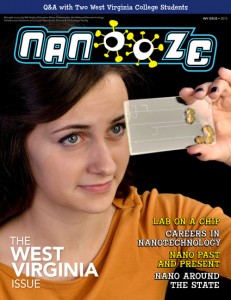
Saturday Gazette-Mail
May 18, 2013
By Mackenzie Mays
CHARLESTON, W.Va. — For the first time, young West Virginia students will have access to a national science magazine tailored to the state’s scientists and technology research.
Nanooze, a publication dedicated to getting kids excited about science — with an emphasis on nanotechnology — has released its first West Virginia edition.
With the help of the state Higher Education Policy Commission’s Division of Science and Research, every eighth-grader in West Virginia will have free access to the magazine. That’s more than 20,000 students.
“This is all about getting kids involved and interested in the science, technology, engineering and mathematics fields. This magazine is a big part of those efforts,” said Kelly Merritt, communication manager at the HEPC. “This was created specifically for West Virginia students to stimulate interest in the STEM fields early on.”
The magazine teaches middle school students about all aspects of nanoscience — from atoms and molecules to electrons and computer chips. It also makes the connections between very small things and their impact on big outcomes, such as cancer treatment and computer development.
In the West Virginia edition, students, professionals and political leaders from the Mountain State are featured. “People in Nano” include Sen. Jay Rockefeller, D-W.Va., for his investments in nanotechnology research and his work as chairman of the Committee on Commerce, Science and Transportation.
The magazine also features a story about how state scientists are trying to improve sensors for use in military, public health and environmental applications, according to the HEPC.
Engineering professors, biochemists and researchers from West Virginia University, Concord University and Marshall University also are featured.
“To be economically competitive now and in the future, West Virginia needs more college graduates, and particularly we need to graduate more people trained in STEM fields,” said Jan Taylor, director for HEPC research programs. “We encourage students to use Nanooze magazine and the guidance of class discussions about science research, discoveries and career opportunities.”
Together, the HEPC and the state Department of Education are encouraging science teachers across the state to implement Nanooze into their lessons, Merritt said.
The Cornell NanoScale Science and Technology Facility publish Nanooze nationally.
An electronic version of Nanooze is available at www.wvresearch.org/nanooze.
# # #
Visit our Press Room for more news about science and research in West Virginia.